How to calculate the power of a gas heating boiler: formulas and calculation example
Before designing a heating system, installing heating equipment, it is important to choose a gas boiler that can generate the necessary amount of heat for the room. Therefore, it is important to choose a device of such power that its performance is as high as possible, and the resource is large.
We will talk about how to calculate the power of a gas boiler with high accuracy and taking into account certain parameters. In the article we presented, all types of heat loss through openings and building structures are described in detail, formulas for their calculation are given. A specific example introduces the features of the production of calculations.
The content of the article:
Typical mistakes when choosing a boiler
The correct calculation of the power of the gas boiler will not only save on consumables, but also increase the efficiency of the device. Equipment whose heat dissipation exceeds actual heat demand will not work efficiently when an insufficiently powerful device cannot heat the room properly.
There is modern automated equipment that independently regulates the gas supply, which eliminates unreasonable expenses. But if such a boiler does its job to the limit, then its life is reduced.
As a result, the efficiency of the equipment decreases, parts wear out faster, and condensation forms. Therefore, it becomes necessary to calculate the optimal power.
There is an opinion that the power of the boiler depends solely on the surface area of the room, and for any home the calculation of 100 W per 1 sq.m will be optimal Therefore, in order to select the capacity of the boiler, for example, for a house of 100 square meters. m, you will need equipment that generates 100 * 10 = 10,000 watts or 10 kW.
Such calculations are fundamentally wrong in connection with the appearance of new finishing materials, improved insulation, which reduce the need to purchase high-power equipment.

Perform power calculation gas boiler There are two ways of heating - manually or using the special Valtec program, which is designed for professional high-precision calculations.
The required power of the equipment directly depends on the heat loss of the room. Having learned the rate of heat loss, you can calculate the power of a gas boiler or any other heating device.
What is room heat loss?
Any room has certain heat losses. Heat leaves walls, windows, floors, doors, and ceilings, so the task of a gas boiler is to compensate for the amount of heat that is released and to provide a certain temperature in the room. This requires a certain thermal power.
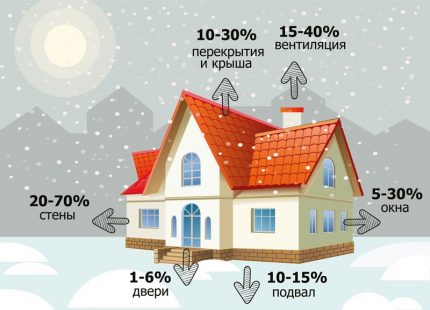
The following factors affect the heat loss of a house.
- The location of the house. Each city has its own climatic features. In calculations of heat loss, it is necessary to take into account the critical negative temperature characteristic of the region, as well as the average temperature and duration of the heating season (for accurate calculations using the program).
- The location of the walls relative to the cardinal points. It is known that a wind rose is located on the north side, so the heat loss of the wall located in this area will be greatest. In winter, a cold wind blows with great force from the western, northern and eastern sides, so the heat loss of these walls will be higher.
- The area of the heated room. The amount of waste heat depends on the size of the room, the area of walls, ceilings, windows, doors.
- Heat engineering of building constructions. Any material has its own coefficient of thermal resistance and heat transfer coefficient - the ability to pass through a certain amount of heat.To find out, you need to use tabular data, as well as apply certain formulas. Information on the composition of walls, ceilings, floors, their thickness can be found in the technical plan of housing.
- Window and doorways. Size, modification of the door and double-glazed windows. The larger the area of the window and door openings, the higher the heat loss. It is important to consider the characteristics of installed doors and double-glazed windows in the calculations.
- Ventilation accounting. Ventilation always exists in the house, regardless of the presence of artificial hoods. Through the open windows, the room is ventilated, air movement is created when the entrance doors are closed and opened, people move from room to room, which contributes to the departure of warm air from the room, its circulation.
Knowing the above parameters, you can not only calculate heat loss at home and determine the power of the boiler, but also to identify places that need additional insulation.
Formulas for calculating heat loss
These formulas can be used to calculate the heat loss not only of a private house, but also of an apartment. Before starting the calculations, it is necessary to depict the floor plan, mark the location of the walls relative to the cardinal points, designate windows, doorways, and also calculate the dimensions of each wall, window and doorways.
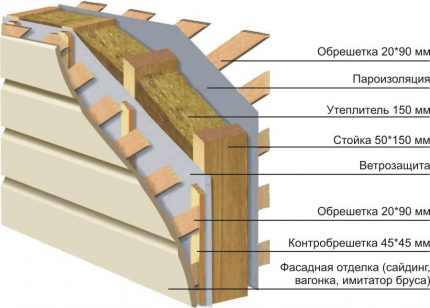
When calculating heat loss, two formulas are used - using the first one, the heat resistance value of the building envelope is determined, and the second one is used for heat loss.
To determine the heat resistance, use the expression:
R = B / K
Here:
- R - the value of thermal resistance of building envelopes, measured in (m2* K) / W.
- K - the coefficient of thermal conductivity of the material of which the enclosing structure is made, is measured in W / (m * K).
- AT - the thickness of the material recorded in meters.
The coefficient of thermal conductivity K is a tabular parameter, the thickness B is taken from the technical plan of the house.
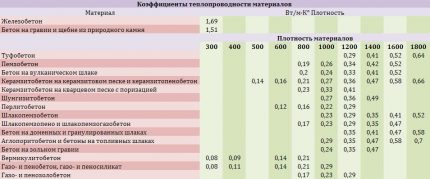
The basic formula for calculating heat loss is also used:
Q = L × S × dT / R
In the expression:
- Q - heat loss, measured in watts.
- S - area of walling (walls, floors, ceilings).
- dT - the difference between the desired temperature of the indoor and outdoor, measured and recorded in C.
- R - value of thermal resistance of the structure, m2• C / W, which is found by the formula above.
- L - coefficient depending on the orientation of the walls relative to the cardinal points.
Having the necessary information at hand, you can manually calculate the heat loss of a building.
Heat loss calculation example
As an example, we calculate the heat loss of a house with specified characteristics.
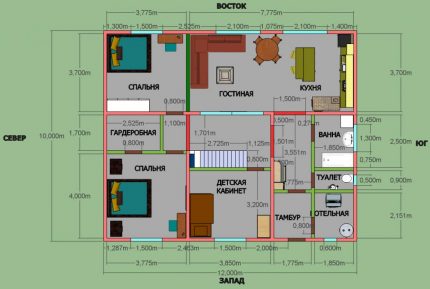
Based on the plan, the width of the structure is 10 m, the length is 12 m, the height of the ceilings is 2.7 m, the walls are oriented to the north, south, east and west. Three windows are built into the western wall, two of them have dimensions 1.5x1.7 m, one - 0.6x0.3 m.
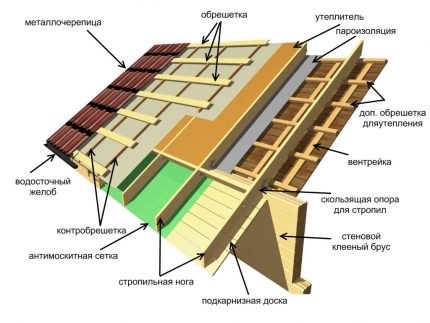
Doors with dimensions of 1.3 × 2 m are integrated in the southern wall, there is also a small window 0.5 × 0.3 m. On the eastern side there are two windows 2.1 × 1.5 m and one 1.5 × 1.7 m.
Walls consist of three layers:
- the lining of the walls of the fiberboard (isoplite) outside and inside is 1.2 cm each, the coefficient is 0.05.
- glass wool located between the walls, its thickness is 10 cm and the coefficient is 0.043.
The thermal resistance of each wall is calculated separately, because takes into account the location of the structure relative to the cardinal points, the number and area of openings. Wall calculation results are summarized.
The floor is multi-layered, over the entire area is made according to one technology, includes:
- the cut board is grooved, its thickness is 3.2 cm, the coefficient of thermal conductivity is 0.15.
- 10 cm thick chipboard dry leveling layer with a coefficient of 0.15.
- insulation - mineral wool 5 cm thick, coefficient 0.039.
Suppose that the floor does not have hatches that worsen heat engineering. Therefore, the calculation is made for the area of all rooms according to a single formula.
The ceilings are made of:
- 4 cm wooden shields with a coefficient of 0.15.
- mineral wool 15 cm, its coefficient is 0.039.
- vapor, waterproofing layer.
Suppose that the ceiling also has no access to the attic above a residential or utility room.
The house is located in the Bryansk region, in the city of Bryansk, where the critical negative temperature is -26 degrees. It has been experimentally established that the temperature of the earth is +8 degrees. Desired room temperature + 22 degrees.
Calculation of wall heat loss
To find the total thermal resistance of a wall, it is first necessary to calculate the thermal resistance of each of its layers.
The glass wool layer has a thickness of 10 cm. This value must be converted into meters, that is:
B = 10 × 0.01 = 0.1
Received a value of B = 0.1. The coefficient of thermal conductivity of thermal insulation is 0.043. Substitute the data in the thermal resistance formula and get:
Rglass=0.1/0.043=2.32
By a similar example, we calculate the resistance to heat of the isoplite:
Risopl=0.012/0.05=0.24
The total thermal resistance of the wall will be equal to the sum of the thermal resistance of each layer, given that we have two fiberboard layers.
R = Rglass+ 2 × Risopl=2.32+2×0.24=2.8
By determining the total thermal resistance of the wall, one can find the heat loss. For each wall they are calculated separately. Calculate Q for the north wall.
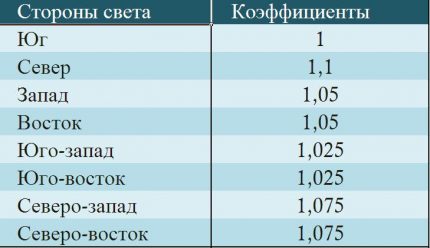
Based on the plan, the northern wall does not have window openings, its length is 10 m, its height is 2.7 m. Then the wall area S is calculated by the formula:
Snorth wall=10×2.7=27
We calculate the parameter dT. It is known that the critical ambient temperature for Bryansk is -26 degrees, and the desired room temperature is +22 degrees. Then
dT = 22 - (- 26) = 48
For the north side, an additional coefficient L = 1.1 is taken into account.
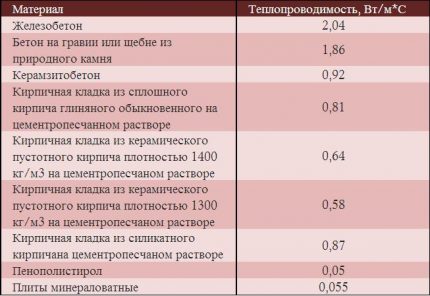
After making preliminary calculations, you can use the formula for calculating heat loss:
Qnorth walls= 27 × 48 × 1.1 / 2.8 = 509 (W)
We calculate the heat loss for the western wall. Based on the data, 3 windows are built into it, two of them have dimensions 1.5x1.7 m and one - 0.6x0.3 m. We calculate the area.
Swest wall1=12×2.7=32.4.
From the total area of the western wall, it is necessary to exclude the area of the windows, because their heat loss will be different. To do this, you need to calculate the area.
Swindow1=1.5×1.7=2.55
Swindow2=0.6×0.4=0.24
For calculations of heat loss, we will use the wall area without taking into account the area of the windows, that is:
Swest wall=32.4-2.55×2-0.24=25.6
For the western side, the incremental coefficient is 1.05. Substitute the obtained data in the main formula for calculating heat loss.
Qwest wall=25.6×1.05×48/2.8=461.
We make similar calculations for the east side. There are 3 windows here, one has dimensions 1.5x1.7 m, the other two - 2.1x1.5 m. We calculate their area.
Swindow3=1.5×1.7=2.55
Swindow4=2.1×1.5=3.15
The area of the eastern wall is:
Seast wall1=12×2.7=32.4
From the total area of the wall we subtract the values of the area of the windows:
Seast wall=32.4-2.55-2×3.15=23.55
The additional coefficient for the eastern wall is -1.05. Based on the data, we calculate the heat loss of the eastern wall.
Qeast wall=1.05×23.55×48/2.8=424
On the southern wall there is a door with parameters 1.3x2 m and a window 0.5x0.3 m. We calculate their area.
Swindow5=0.5×0.3=0.15
Sthe door=1.3×2=2.6
The area of the southern wall will be equal to:
Ssouth wall1=10×2.7=27
We determine the area of the wall excluding windows and doors.
Ssouth walls=27-2.6-0.15=24.25
We calculate the heat loss of the south wall, taking into account the coefficient L = 1.
Qsouth walls=1×24.25×48/2.80=416
Having determined the heat loss of each wall, you can find their total heat loss by the formula:
Qthe walls= Qsouth walls+ Qeast wall+ Qwest wall+ Qnorth walls
Substituting the values, we get:
Qthe walls= 509 + 461 + 424 + 416 = 1810 W
As a result, the heat loss of the walls amounted to 1810 watts per hour.
Calculation of heat losses of windows
There are 7 windows in the house, three of them have dimensions 1.5 × 1.7 m, two - 2.1 × 1.5 m, one - 0.6 × 0.3 m and one more - 0.5 × 0.3 m.
Windows with dimensions of 1.5 × 1.7 m is a two-chamber PVC profile with I-glass. From the technical documentation you can find out that its R = 0.53. Windows with dimensions of 2.1 × 1.5 m are two-chamber with argon and I-glass; they have thermal resistance R = 0.75, windows 0.6x0.3 m and 0.5 × 0.3 - R = 0.53.
The area of the windows was calculated above.
Swindow1=1.5×1.7=2.55
Swindow2=0.6×0.4=0.24
Swindow3=2.1×1.5=3.15
Swindow4=0.5×0.3=0.15
It is also important to consider the orientation of the windows relative to the cardinal points.
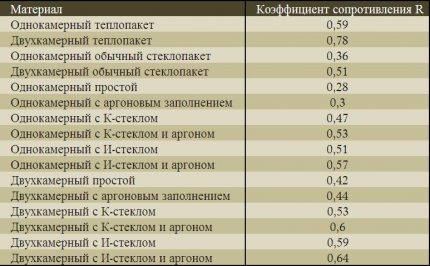
We calculate the heat loss of the western windows, taking into account the coefficient L = 1.05. On the side are 2 windows with dimensions of 1.5 × 1.7 m and one with 0.6 × 0.3 m.
Qwindow1=2.55×1.05×48/0.53=243
Qwindow2=0.24×1.05×48/0.53=23
Total total losses of the western windows are
Qsub window=243×2+23=509
In the south side is a window 0.5 × 0.3, its R = 0.53. We calculate its heat loss taking into account the coefficient of 1.
Qsouth window=0.15*48×1/0.53=14
On the eastern side there are 2 windows with dimensions 2.1 × 1.5 and one window 1.5 × 1.7. We calculate the heat loss taking into account the coefficient L = 1.05.
Qwindow1=2.55×1.05×48/0.53=243
Qwindow3=3.15×1.05×48/075=212
We summarize the heat loss of the eastern windows.
Qeast window=243+212×2=667.
The total heat loss of the windows will be equal to:
Qwindows= Qeast window+ Qsouth window+ Qsub window=667+14+509=1190
Total through the windows comes out 1190 watts of thermal energy.
Determination of door heat loss
The house has one door, it is built into the south wall, has dimensions of 1.3 × 2 m. Based on the passport data, the thermal conductivity of the door material is 0.14, its thickness is 0.05 m. Thanks to these indicators, you can calculate the thermal resistance of the door.
Rthe door=0.05/0.14=0.36
For calculations, you need to calculate its area.
Sthe door=1.3×2=2.6
After calculating the thermal resistance and area, you can find the heat loss. The door is located on the south side, so we use an additional factor of 1.
Qthe door=2.6×48×1/0.36=347.
Total, 347 watts of heat comes out through the door.
Calculation of thermal resistance of the floor
According to technical documentation, the floor is multi-layered, it is made equally throughout the area, has dimensions of 10x12 m. We calculate its area.
Sgender=10×12=210.
The composition of the floor includes boards, chipboard and insulation.
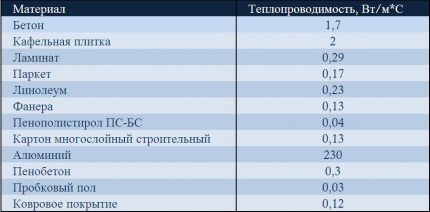
Thermal resistance must be calculated for each floor layer separately.
Rboards=0.032/0.15=0.21
Rchipboard=0.01/0.15= 0.07
Rwill insulate=0.05/0.039=1.28
The total heat resistance of the floor is:
Rgender= Rboards+ Rchipboard+ Rwill insulate=0.21+0.07+1.28=1.56
Given that in winter the temperature of the earth is kept at +8 degrees, the temperature difference will be equal to:
dT = 22-8 = 14
Using preliminary calculations, you can find the heat loss at home through the floor.
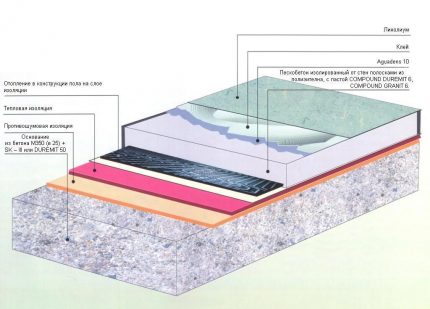
When calculating the heat loss of the floor, we take into account the coefficient L = 1.
Qgender=210×14×1/1.56=1885
The total heat loss of the floor is 1885 watts.
Calculation of heat loss through the ceiling
When calculating the heat loss of the ceiling, a layer of mineral wool and wooden panels are taken into account. Steam- and waterproofing does not participate in the process of thermal insulation, therefore we do not take it into account. For calculations, we need to find the thermal resistance of wooden boards and a layer of mineral wool. We use their thermal conductivity coefficients and thickness.
Rvillage shield=0.04/0.15=0.27
Rmin.=0.05/0.039=1.28
The total heat resistance will be equal to the sum of Rvillage shield and Rmin..
Rthe roof=0.27+1.28=1.55
The ceiling area is the same as the floor.
S the ceiling = 120
Next, the calculation of the heat loss of the ceiling, taking into account the coefficient L = 1.
Qthe ceiling=120×1×48/1.55=3717
Total through the ceiling goes 3717 watts.
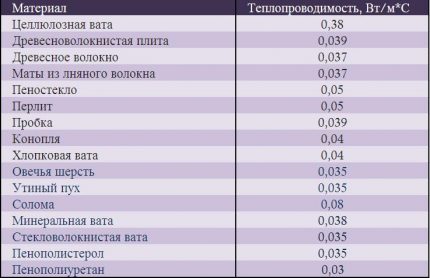
To determine the total heat loss at home, it is necessary to add the heat loss of the walls, windows, doors, ceiling and floor.
Qtotal= 1810 + 1190 + 347 + 1885 + 3717 = 8949 W
To heat a house with the specified parameters, a gas boiler is needed that supports a power of 8949 W or about 10 kW.
Determination of heat loss taking into account infiltration
Infiltration is a natural process of heat exchange between the external environment, which occurs when people move around the house, when opening entrance doors, windows.
For calculating heat loss for ventilation you can use the formula:
Qinf= 0.33 × K × V × dT
In the expression:
- K - the calculated rate of air exchange, for living rooms use a coefficient of 0.3, for rooms with heating - 0.8, for a kitchen and a bathroom - 1.
- V - the volume of the room, calculated taking into account the height, length and width.
- dT - temperature difference between the environment and the apartment building.
A similar formula can be used if ventilation is installed in the room.
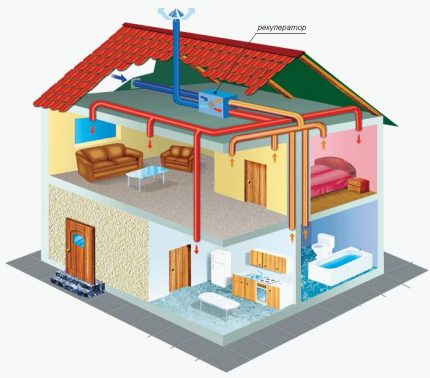
The height of the room is 2.7 m, width - 10 m, length - 12 m. Knowing these data, you can find its volume.
V = 2.7 × 10 × 12 = 324
The temperature difference will be equal to
dT = 48
As the coefficient K, we take the indicator 0.3. Then
Qinf=0.33×0.3×324×48=1540
Q should be added to the total Qinf. Eventually
Qtotal=1540+8949=10489.
Total, taking into account the infiltration of heat loss at home will be 10489 watts or 10.49 kW.
Calculation of boiler power
When calculating the boiler capacity, it is necessary to use a safety factor of 1.2. That is, the power will be equal to:
W = Q × k
Here:
- Q - heat loss of the building.
- k - safety factor.
In our example, substitute Q = 9237 W and calculate the required boiler power.
W = 10489 × 1.2 = 12587 W.
Given the safety factor, the required boiler capacity for heating a house is 120 m2 equal to approximately 13 kW.
Conclusions and useful video on the topic
Video instruction: how to calculate heat loss at home and boiler power using the Valtec program.
Competent calculation of heat loss and power of a gas boiler using formulas or software methods allows you to determine with high accuracy the necessary parameters of the equipment, which makes it possible to exclude unreasonable fuel costs.
Please write comments in the block form below. Tell us about how heat loss was calculated before buying heating equipment for your own summer house or country house. Ask questions, share information and photos on the topic.

 Calculation of air heating: basic principles + calculation example
Calculation of air heating: basic principles + calculation example  Calculation of the heating system of a private house: rules and examples of calculation
Calculation of the heating system of a private house: rules and examples of calculation  Calculation of water heating: formulas, rules, examples of implementation
Calculation of water heating: formulas, rules, examples of implementation 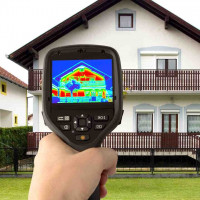 Thermotechnical calculation of a building: specifics and formulas for performing calculations + practical examples
Thermotechnical calculation of a building: specifics and formulas for performing calculations + practical examples 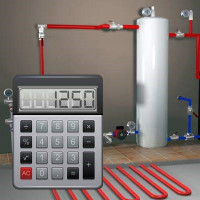 The average gas consumption for heating a house is 150 m²: an example of calculations and an overview of heat engineering formulas
The average gas consumption for heating a house is 150 m²: an example of calculations and an overview of heat engineering formulas 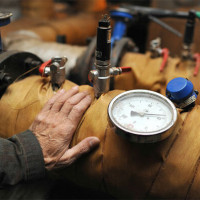 House-wide heating meters: procedure and options for calculating heating
House-wide heating meters: procedure and options for calculating heating  How much does it cost to connect gas to a private house: the price of organizing gas supply
How much does it cost to connect gas to a private house: the price of organizing gas supply  The best washing machines with dryer: model rating and customer tips
The best washing machines with dryer: model rating and customer tips  What is the color temperature of light and the nuances of choosing the temperature of the lamps to suit your needs
What is the color temperature of light and the nuances of choosing the temperature of the lamps to suit your needs  Replacement of a geyser in an apartment: replacement paperwork + basic norms and requirements
Replacement of a geyser in an apartment: replacement paperwork + basic norms and requirements
And how did we buy a boiler with a father-in-law? We came to the store, the seller asked the area of the house, and showed what to choose from. I said the father-in-law, take with a margin of power, but he is fisted, took it close.
And what do you think? The boiler puffs at a maximum, does not turn off, and in a house above 19-20 ° C it does not warm up. Now we will buy polystyrene and insulate the walls. And then he saves, I insist on 10 mm, and he says 5 mm is enough. And the roof, too - the wind walks. Heat loss is strongly affected, it is a fact.
Skimp on home heating = banging your teeth in winter and spending even more on warming. Fact. Therefore, you should always take a boiler whose power is at least slightly higher than that which is assumed to be the area of your home. Then the device will not work to the limit of its capabilities, and heat losses are compensated. Although, of course, it is better to try to minimize them in order to save on payments for electricity.